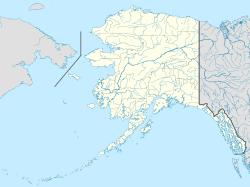Shaktoolik, Alaska facts for kids
Quick facts for kids
Shaktoolik
|
|
|---|---|
| Country | United States |
| State | Alaska |
| Census Area | Nome |
| Incorporated | October 7, 1969 |
| Area | |
| • Total | 1.08 sq mi (2.79 km2) |
| • Land | 1.07 sq mi (2.77 km2) |
| • Water | 0.01 sq mi (0.02 km2) |
| Elevation | 23 ft (7 m) |
| Population
(2020)
|
|
| • Total | 212 |
| • Density | 198.50/sq mi (76.67/km2) |
| Time zone | UTC-9 (Alaska (AKST)) |
| • Summer (DST) | UTC-8 (AKDT) |
| ZIP code |
99771
|
| Area code | 907 |
| FIPS code | 02-68890 |
| GNIS feature ID | 1669434 |
Shaktoolik (also known as Inupiaq: Saktuliq or Central Yupik: Cagtuleq) is a small city in Nome Census Area, Alaska, United States. It is located in a beautiful but challenging part of Alaska. The city's population was 212 people in 2020. Shaktoolik is special because it is one of the Alaskan towns facing big challenges from global warming. The land around it is slowly eroding, which means it's washing away. Because of this, the community has had to move its location two times!
Contents
History of Shaktoolik: A Moving Community
Shaktoolik has a long and interesting history. It was one of the first settlements of the Malemiut people on Norton Sound. People lived here as early as 1839. Nearby, at the Iyatayet site, archaeologists found tools and signs of human life from 6,000 to 8,000 years ago. This makes it a very old and important historical place.
How Shaktoolik Got Its Name
The name "Shaktoolik" comes from an Unaliq word, "suktuliq." This word means "scattered things." A Russian explorer named Lt. Lavrenty Zagoskin first mapped the area in the 1840s. He called the place "Tshaktogmyut."
Why Shaktoolik Moved Twice
Around 1905, people in the Shaktoolik area managed herds of reindeer. The village was first located about six miles up the Shaktoolik River. In 1933, the community moved to the mouth of the river. However, this new spot was often hit by strong storms and winds. Because of the harsh weather, the village moved again in 1967. Its current location is more protected from the elements. Today, only two homes are still used at the old townsite. The city officially became a city in 1969.
Geography and Climate of Shaktoolik
Shaktoolik is located on the eastern shore of Norton Sound. This is a large inlet of the Bering Sea. It is about 125 miles east of Nome, another Alaskan city. Shaktoolik is also about 33 miles north of Unalakleet.
Understanding Shaktoolik's Climate
Shaktoolik has a subarctic climate. This means it has long, cold winters and short, cool summers. When Norton Sound is not frozen, usually from May to October, the ocean affects the weather. Summer temperatures are usually between 47 and 62 degrees Fahrenheit. Winter temperatures average from -4 to 11 degrees Fahrenheit. However, temperatures can be extreme, from -50 to 87 degrees Fahrenheit! The area gets about 14 inches of rain each year, including about 43 inches of snow.
People and Life in Shaktoolik
The people of Shaktoolik have a unique way of life. In 2020, the city had 212 residents. Most of the people living in Shaktoolik are Native American.
How People Live and Work
Life in Shaktoolik is largely based on subsistence. This means people get much of their food directly from nature. They also have some part-time jobs to earn money. Some people work in commercial fishing. Others work for the city government or at the local school. Reindeer herding is also important for both income and food.
Traditional Foods and Activities
The community relies on many traditional foods. These include fish, crab, and moose. They also hunt beluga whale, caribou, and seal. Smaller animals like rabbit, geese, cranes, and ducks are also important. People gather berries, greens, and roots. These activities are a big part of their culture and daily life.
Education in Shaktoolik
Students in Shaktoolik attend Shaktolik School. This school serves children from pre-kindergarten all the way to 12th grade. It is part of the Bering Strait School District.
Sports and Activities for Students
During the school year, students have many chances to join sports. In the fall, they can participate in cross country running, wrestling, and volleyball. Basketball is very popular and is played throughout the winter. Near the end of the school year, students can join the Native Youth Olympics (NYO). Students from Shaktoolik form teams and travel to compete with other schools in the Bering Strait School District.
Notable People from Shaktoolik
Shaktoolik has been connected to some interesting people.
- Ticasuk Brown (1904–1982) was an important educator and writer. She was born in nearby Unalakleet. Her father was one of the people who helped start the village of Shaktoolik. Ticasuk wrote a lot about her life and experiences in Alaska.
- Félix Rodríguez de la Fuente (1928–1980) was a famous Spanish naturalist and TV host. He sadly died in Shaktoolik on March 14, 1980. He was filming a documentary about the Iditarod Trail Sled Dog Race when his small plane crashed. Everyone on board, including two Spanish cameramen and the American pilot, died in the accident.
See also
 In Spanish: Shaktoolik para niños
In Spanish: Shaktoolik para niños



